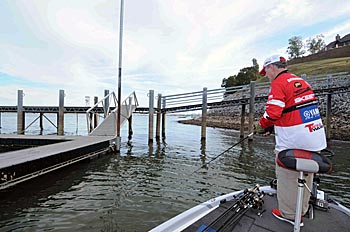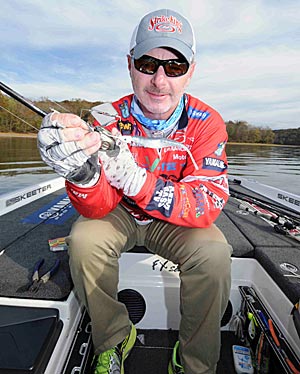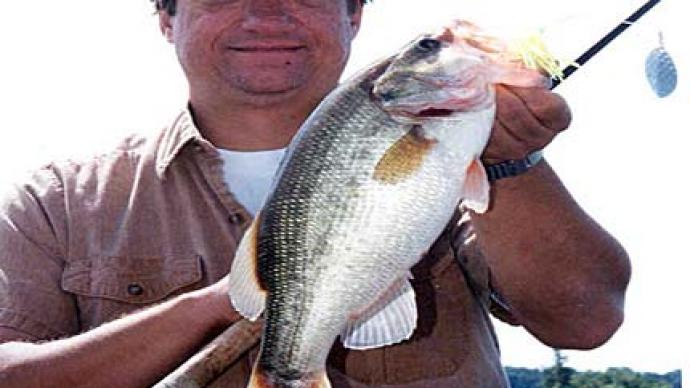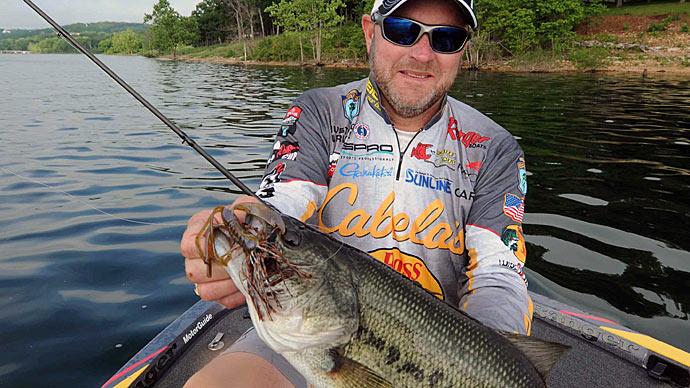
A bass is aggressive when guarding its fry, so it should be easy to make that fish bite anything you throw.
Bassmaster Elite Series pro Mark Menendez knows it is not easy to catch bass guarding fry even though the fish will attack anything threatening its young ones. “The bass are in a mood where they are guarding their fry, and they are generally higher in the water column,” Menendez says. “So traditional presentations of Texas rigs and shaky heads and jigs falling in the water column don’t work that well. You have to go to some alternatives then.”
Two of the Kentucky pro’s favorite alternatives are a wacky-rigged finesse worm, and a 6-inch floating worm rigged Texas style to make the lure weedless. He has also caught bass guarding fry with a buzz bait and a floating stickbait.
Menendez impales his floating worm on a 3/0 offset round bend Gamakatsu hook tied to 12- or 15-pound Seaguar InvizX fluorocarbon. “I would prefer to use a 4/0, but that would make the worm sink so much faster than the 3/0,” he says. He uses a VMC Neko Hook with a weedguard for his wacky-rigged finesse worm and ties it on a leader line of 12- or 15-pound Seaguar InvizX and a main line of 15- or 20-pound Seaguar Smackdown braid.
Twitching and pausing both the finesse worm and floating worm near the surface tempts bass guarding fry. Menendez tries to keep the lures in sight most of the time when working the baits around the fry. “There are times when you get towards that later guarding period (bass will guard fry for 7 to 10 days), the bigger fry will have some range to them, so that is when I let that worm get deeper,” Menendez says. When he fishes with the floating stickbait, Menendez twitches the lure and lets it float back to the surface rather than employing the standard stickbait retrieve of two to three jerks followed by a pause.

Bass guarding fry can usually be found in the backs or sides of spawning pockets, depending on the size of the fry. “If the fry are ultra-small and relatively young, look more towards the spawning areas in the backs of bays,” Menendez says. “As those fry get bigger and wind and weather move them around, you can look more towards the sides of those same spawning pockets.” The fry will relate to any cover that provides plenty of protection, such as boat docks, buck brush, or willow trees.
The depth of the fry will vary. “The bass are going to spawn in relatively shallow water, but sometimes they can be out there on the end of a boat dock that could be over 12 to 20 feet of water,” Menendez says. The touring pro notes the fry will still be close to the spawning area even if the hatchlings are suspended over deeper water.
Sometimes fry are visible as black balls of tiny fish on the surface, but Menendez admits since he has gotten older, it is tougher for him to see those black balls, so he looks for other telltale signs that indicate fry are present. “One of those telltale signs is when you are retrieving a spinnerbait or a swim jig or something like that, and as you are watching your bait come back, you will see the water start to rain (the surface dimpling), and that is those little fry,” he says. “Your retrieve gives most of it away then.”
Occasionally you will also see the male bass cruising around the fry in protection mode. “A lot of times, they will give themselves away,” Menendez says. Menendez noticed bass pushing water along the surface during the recent Toyota Bassmaster Texas Fest at Lake Fork. This signaled to him that the fish were chasing away bluegill and other predators from the fry. Menendez claims he caught “several good keepers” guarding fry during the Texas Fest.
When he finds fry, Menendez casts past the young fish and works his lure through the fry to get the attention of the male guarding bass. “I want to interrupt those fry to make sure if there is a guarding bass there, I will get its attention,” Menendez says. “So your lure has to be in and amongst those fry.”
Menendez considers ideal conditions for the guarding fry pattern are clear water--so the protector bass can see intruders “coming to mess with its babies”--and calm weather. “The less wind you can get, the better off you are so you can see the fry,” Menendez says.
The fry pattern can last for several weeks in the spring on larger reservoirs by following the spawn down the lake. Menendez suggests fry start showing up after the water temperature climbs to about 68 degrees and the guarding bass leaves its young ones at about 75 degrees. Fry first show up in the upper section of a lake and a week or two later appear in the mid-lake section. Lastly, fry appear one to two weeks later on the lower end of the lake. “So you may get six to 10 weeks depending if you get two or three waves of fish coming in to fish this pattern,” Menendez says.
BassResource may receive a portion of revenues if you make a purchase using a link above.




